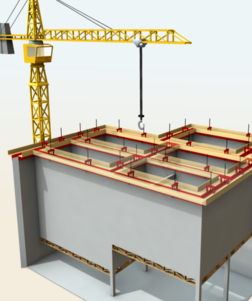
Cylindrical slipforming
To slipform constant cross-sections – or cross-sections which do not change with height – the formwork with all working decks is raised onto climbing tubes by means of hydraulic jacks. Slipforming is a process that raises the formwork through a series of quasi-continuous perpendicular lifts and takes place simultaneously with all other normal operations in the construction process., i.e. forming, reinforcing, pouring concrete and curing.
CYLINDRICAL SLIPFORMING
SUBCATEGORIES
Round silos
Slipforming is based on the idea of constantly moving the formwork construction upwards – along with all necessary working decks. In contrast to other formwork systems, the slipform formwork is moved across the entire area that contacts the concrete. During forming, the formwork structure only covers as much concrete surface as is necessary to give the concrete sufficient strength before it leaves the formwork.
The formwork is supported via so-called climbing tubes on hardened concrete located on the lower levels and is then raised in intervals by means of hydraulic jacks. The lifting height per interval is approx. 2.5 cm, whereby a lift takes place every 5 to 15 minutes depending on the slipforming speed.
Changes in wall thickness can be made by insert forms. The wall thickness can be increased by dropping insert forms, that have been previously installed before slipform start. Furthermore, by adding the insert forms at a certain height during the slipforming process, the wall thickness can be reduced. Slipforming also allows for easy forming of butresses (e.g. horizontal posttensioning).
Concrete and reinforcement are installed continuously and in parallel to the formwork process. All necessary working decks are integrated into the formwork system and are lifted together with the slipform. To ensure a continuous installation process, the vertical reinforcement is installed with a height offset. The horizontal reinforcement can only be installed in the area between the upper edge of the formwork panel and the lower edge of the yoke channel (distance approx. 70–90 cm). It is therefore not possible to install the horizontal reinforcement in advance.
Gleitbau has world-wide experience when it comes to designing and constructing storage silos by means of cylindrical slipforming – from single grain silos to huge plants for industrial products with 30 silo cells or more.
Silo construction is a traditional application of the slipforming technique. Nevertheless, Gleitbau’s engineers strive for modern, individual and economical improvements. One way of achieving this is through a combination of construction methods, such as sliding building elements and the use of a special formwork for the inner cone. Furthermore, heavy lifting technology can be offered for use in the construction of cones and roofs.
SUBCATEGORIES
Multi-cell silos
The geometry of a structure must be suitable for slipforming. Nevertheless, it is possible to integrate a blockout formwork to create recesses and wall openings for windows, doors or reinforcement connections. Even prefabricated elements and inserts for wall thickness alterations can be integrated into the formwork system.
Because the concrete sets in the moving formwork, it is necessary to ensure continuous, even movement of the formwork. This is why slipforming is designed for continuous 24-hour operation.
Consequently, the entire construction process requires precise and comprehensive planning and work preparation.
Large and high wall openings can be created by using a insert formwork. This type of formwork is used to create a vertical support for the subsequent layer of concrete and forms a lintel above the wall opening to rest on. To allow these formwork components to absorb not only the load of the concrete but also the weight of the slipform formwork (climbing tubes) during the subsequent steps of continued construction, appropriate static dimensioning and design is crucial.
Prefabricated components as well as rebend connections, steel components, etc. can also be installed during the sliding process. The advantage of short execution times can be further improved upon by combining the slipform construction method with the use of prefabricated parts.
Embedded items are attached (welded) to the reinforcement and must be reliably secured against horizontal and vertical displacement. Furthermore, any embedments must be 1‒2 cm smaller than the wall thickness to prevent any shearing or damage when slipforming over the opening.
Smaller components (up to an edge length of approx. 50 cm) can be made of plastic (e.g. polystyrene), whereas wooden box-outs will be used for larger recesses. The yoke division must take into account recesses and wall openings. In the area of the recesses or wall openings, climbing tubes must be braced at a distance of 40 cm.







